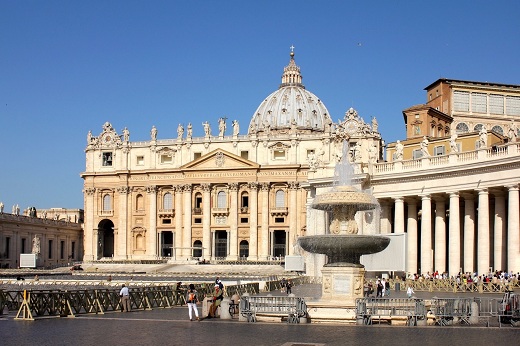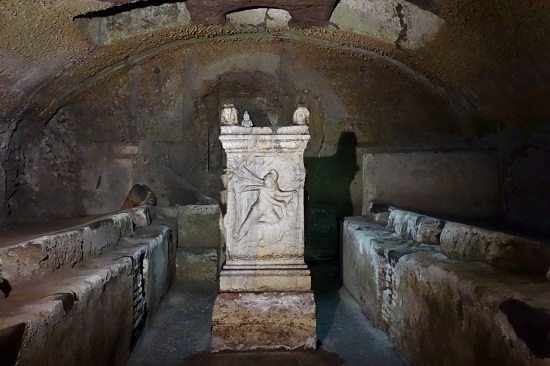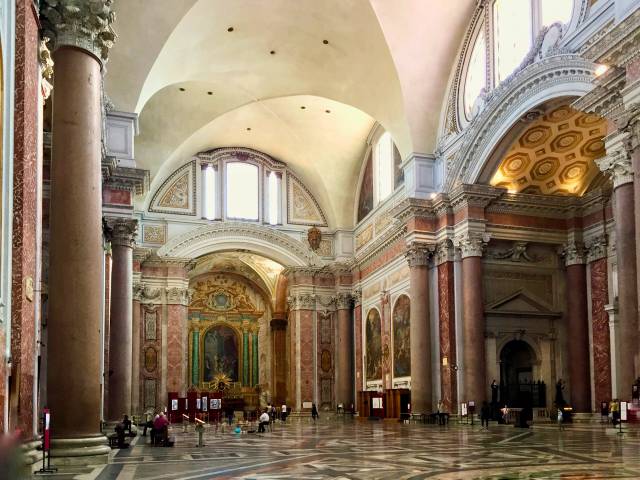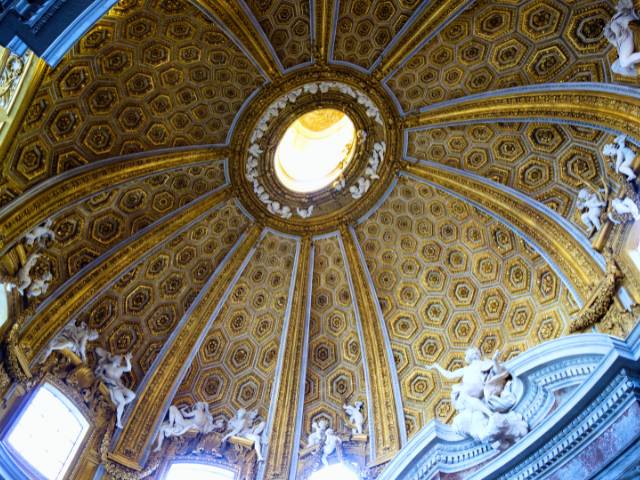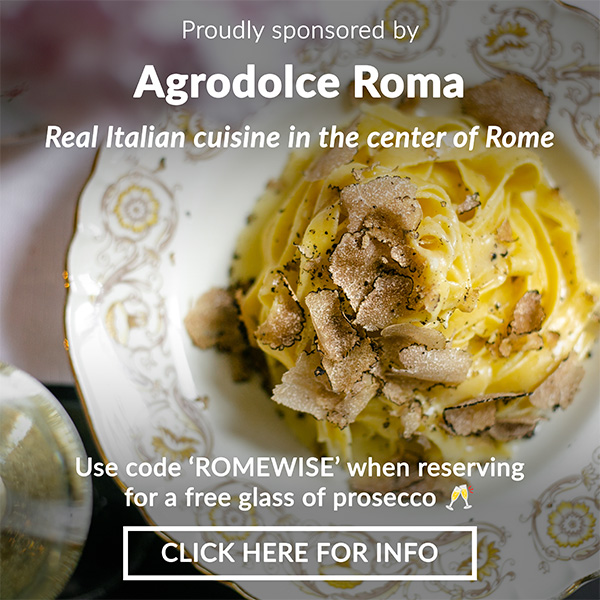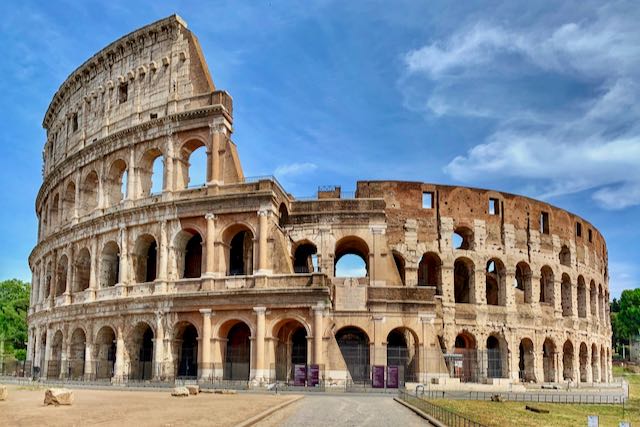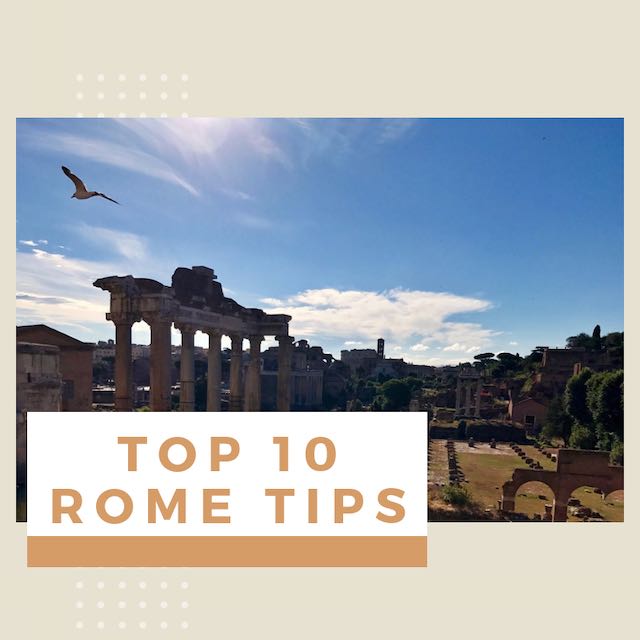- Sign up & get a FREE ebook Subscribe NOW!
- Romewise Home Page
- churches in rome
Exploring the Many Churches in Rome
With over 900 wonderful churches in the city, Rome stands out as a place of religious history and cultural significance.
 The stunning interiors of churches in Rome like Sant'Andrea delle Valle is just one of the reasons to visit as many churches as possible here!
The stunning interiors of churches in Rome like Sant'Andrea delle Valle is just one of the reasons to visit as many churches as possible here!Seeing all of the churches is a lifetime of work, but we've picked out some of what we think are the most interesting for you to see during your visit!
Visiting churches in Rome - Everything you need to know
In the midst of the busy city, sometimes you just need to find a quiet spot for some time out and contemplation.
Luckily, no matter where you are in Rome you will find a church near you, offering sanctuary and beauty to admire.
Ranging from large and ornate to small and intimate, Rome’s churches are fascinating snapshots of times gone by and a window into how religion is practised in the city today.
 There are so many churches in Rome that it would be tough to list them all here, but we've chosen our favorites to get you started!
There are so many churches in Rome that it would be tough to list them all here, but we've chosen our favorites to get you started!On this page we'll explore some of the most interesting and beautiful churches you can see in the city, including:
- The Papal basilicas
- Churches with amazing art
- Churches with early Christian origins
- Churches from the medieval period
- Baroque and Renaissance churches
The Papal Basilicas
The four papal or major basilicas in Rome are Saint Peter's Basilica, San Giovanni in Laterano and San Paulo Fuori le Mure and Santa Maria Maggiore.
⭐️ Marvel at Rome's Stunning Architecture ⭐️
Dive into Rome's majestic basilicas and architectural marvels. Visit San Giovanni, Santa Maria Maggiore, and the Pantheon to uncover the rich history and beauty of these iconic sites.
Saint Peter's Basilica
The most famous of all Catholic churches, Saint Peter's Basilica was built on the site of Saint Peter's grave by the first Christian Roman emperor: Constantine.
In the early 1500's, Pope Julius II decided it was time for an upgrade.
The construction of the massive building that still leaves us in awe today lasted over a century.
It was overseen by the greatest artists and architects of the Renaissance, including Bramante, Michelangelo (who designed the dome, that holds a relic from the holy cross at the highest point) and Bernini.
It’s free to visit, but it does get very busy.
As you might imagine, St Peter's Basilica is huge and inside there is a lot to see, so if you visit either early or late in the day, there’s more chance you can see it all in peace.
The Sistine Chapel is not within St Peter's Basilica, it is a separate building that is accessed from the Vatican Museums.
Find out all you need to know about how to visit the Sistine Chapel in our dedicated page
The Basilica of Saint John in Lateran
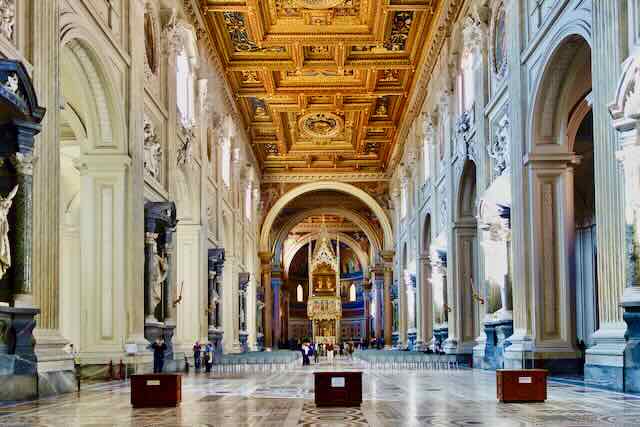 The stunning interior of the basilica of John in Lateran reflects the importance of this ancient church
The stunning interior of the basilica of John in Lateran reflects the importance of this ancient churchThis 'Mother of all Churches' is technically the oldest Catholic church in Rome and arguably the most important of the four major basilicas.
Originally built between 313-324, after earthquakes, fires, and vandalism, not much of the original building survives today.
In what was the height of the Baroque era and the Counter-Reformation in the 17th century, architect Borromini was assigned by Pope Innocentius X to create the beautiful basilica we can admire today.
The Basilica of Saint Paul Outside the Walls
Built in the 4th century this severe, palace-like church was constructed on the burial site of Saint Paul.
It was located outside the city walls at the time, which is how it got its name.
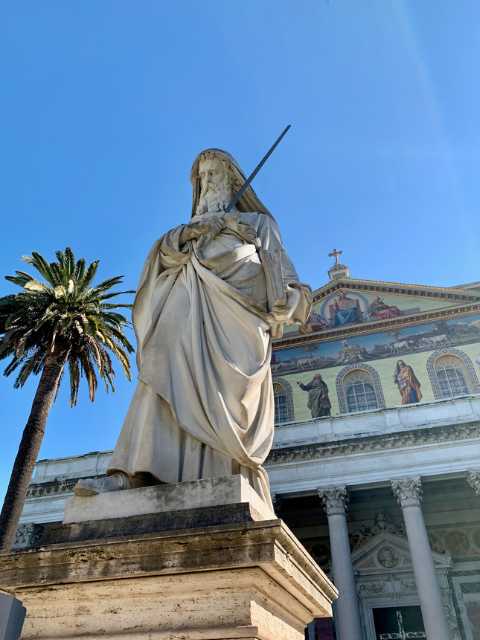 This church is dedicated to Saint Paul and while mostly not as old as the other major basilicas, it's just as important!
This church is dedicated to Saint Paul and while mostly not as old as the other major basilicas, it's just as important!Sadly, a fire in 1823 destroyed much of the church, though some original areas do still survive.
It was lovingly restored in 1840 and declared a national monument.
No matter what season you visit Rome, here are 4 essential things we recommend never leaving home without:
Disclosure: If you make a purchase through a link on this page, I may receive a small commission - at no extra cost to you. Thank you for supporting my site!
Santa Maria Maggiore
Santa Maria Maggiore is one of the churches in Rome with a very interesting founding legend, 'commissioned' by the Virgin Mary herself.
She came to a Roman Christian in a vision, telling him to build a church on the spot where it would snow.
It was August.
Anyone who has visited Rome in August understands that snow during this boiling-hot month would be a miracle!
But snow it did, so Pope Liberius came over to the Esquiline hill and drew the contours of the church around the snowfall.
Over the centuries, Santa Maria Maggiore has been altered and extended many times.
Ready to plan your trip?
Book your train
Planning to travel between cities in Italy and other parts of Europe?
Use Trainline to see all the different options available across the different rail companies.
Find your hotel
Find your perfect place to stay in Rome.
Use Booking.com to choose between hotels, guesthouses, and self-catering apartments in neighborhoods throughout the Eternal City.
Buy your TurboPass
Purchase the convenient Turbopass and visit all of Rome's top attractions including the Colosseum, Pantheon, and Vatican.
With one handy pass, it's all included.
Churches in Rome where you can see amazing art
As entering churches in Rome is free, it’s a great way to see some art while you’re visiting.
However, you might wanna take some Euro coins with you, to put into the box near the artworks to light them up and see them in all their glory!
San Luigi dei Francesi
The French national church was completed in 1589 and is famous for housing three masterpieces on the life of Saint Matthew by Caravaggio.
These mesmerizing paintings were Caravaggio's first big commission in Rome and are still on display in the chapel he created them for (the last one on the left).
The church is located a few steps away from Piazza Navona and the Pantheon at Piazza di San Luigi de’ Francesi.
Santa Maria Sopra Minerva
Santa Maria Sopra Minerva was first founded in the 7th century, over the ruins of a pagan temple dedicated to Minerva.
It was rebuilt in the 13th-century Gothic style with the facade finished during the Renaissance.
Inside you can see the statue of Christ the Redeemer by Michelangelo and a series of frescoes by Filippino Lippi.
 This sculpture by Michelangelo gets less visitors than his other masterpieces so take advantage of the lack of crowds and study it all you want!
This sculpture by Michelangelo gets less visitors than his other masterpieces so take advantage of the lack of crowds and study it all you want!Santa Maria della Vittoria
Built between 1608 and 1620 and located on Via XX Settembre 17, this church was named for the Catholic army’s victory over the Bohemians in 1620.
The jewel in the crown of this beautiful church is a sculpture by Gian Lorenzo Bernini depicting the Ecstasy of Saint Teresa.
 Photos do not do this sculpture justice, so make sure to visit the church in person and see it for yourself
Photos do not do this sculpture justice, so make sure to visit the church in person and see it for yourselfSan Pietro in Vincoli
The origins of this church, 'Saint Peter in Chains' in English, go all the way back to the 5th century when Pope Leo the Great came into possession of the chains that had once bound Saint Peter.
The chains, when brought together, merged into one, and the church was built to remember this miracle.
Today, it’s better known for housing Michelangelo’s 'Moses'.
This was supposed to be part of a grand tomb for Pope Julius II but he died before it was finished and his successor had the work installed in this church rather than St Peter's Basilica.
 While the original plan was for something much grander than the final result, it is said that Michelangelo considered the figure of Moses one of the best pieces of work he'd ever done
While the original plan was for something much grander than the final result, it is said that Michelangelo considered the figure of Moses one of the best pieces of work he'd ever doneSanta Maria del Popolo
Located on Piazza del Popolo, this 15th-century Renaissance church is home to two Caravaggio paintings, The Crucifixion of St Peter and The Conversion of St Paul, in the Cersai chapel.
In another chapel that Raphael designed for the Chigi family, the statues of Daniel and the Lion and Habakkuk and the Angel by Bernini were added about 150 years later.
Basilica di Sant'Agostino
One of the first churches with Renaissance features is located just off Piazza Navona.
It houses a famous painting by Caravaggio, the Madonna of the Pilgrims and Raphael's fresco of the Prophet Isaiah.
The perfect 3-day itinerary in Rome
Trying to figure out how to organize your visit to Rome? I've got the perfect 3-day itinerary for first-time visitors (or those who have not been here in a while.) It works for a 2.5 day visit as well.
In my 3-day itinerary, you'll see all the major must-see Rome attractions like the Vatican, Colosseum, Trevi Fountain, Pantheon, Piazza Navona, Spanish Steps, Castel Sant'Angelo, and much more.
And if you have more time, or want suggestions for extra/other things to do, you'll find that there too.
Visit my page with the best 3-day itinerary in Rome for first-timers.
Churches with ancient origins
After emperor Constantine converted to Christianity at the beginning of the fourth century, the first Christian churches in Rome were built.
Though some were damaged by fire and neglect, and were added to, rebuilt, renovated and refurbished, it is still possible to see the ancient and original features of many of these beautiful churches.
The Pantheon
The life of this incredible temple dates back to 27 BCE when the first Roman emperor, Augustus, commissioned it to be built.
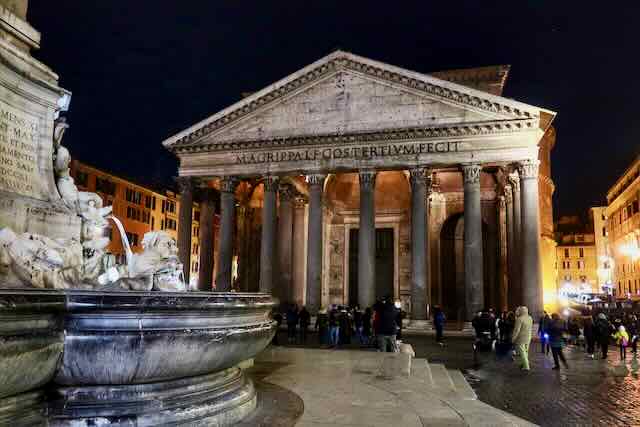 The iconic Pantheon is one of Rome's most popular sights for good reason, I never get tired of seeing it!
The iconic Pantheon is one of Rome's most popular sights for good reason, I never get tired of seeing it!The current structure dates from around 126 CE, built by emperor Hadrian after the original was damaged by fire.
The Pantheon was turned into a church in the 7th century which preserved it for the future.
Located on Piazza della Rotonda, it’s been reconstructed, added to and altered over the years, but the building is basically as the Romans would have seen it.
The Basilica dei Santi Cosma e Damiano
Originally adapted from two separate buildings in the 4th century, the entire church was lifted when the ground level on the Forum had risen over the centuries.
After the excavation of the Forum, the building was separated into two.
There is the church you now enter from the Via dei Fori Imperiali, and the ancient temple you now enter through the original doors from the Roman Forum.
Santa Pudenziana
Built in the 4th century on the remains of a Roman house from the 2nd century, this church is dedicated to Santa Pudentiana, an early Christian martyr.
The church was rebuilt and altered over the centuries but you can still see the original late antique mosaic in the apse.
San Clemente
One of the best churches in Rome to see all its layers of history, this 4th-century church is located on Via di San Giovanni in Laterano near the Colosseum.
Descend the steps through the layers of history on which the church was built, down to the ancient Roman street level.
 The cloister you see when you first walk through the gate is much more recent than what you will see down below
The cloister you see when you first walk through the gate is much more recent than what you will see down belowIt’s an interesting building which has been reconstructed and rebuilt many times, but the underground excavations are particularly fascinating.
While you can (and I do!) walk into the church whenever it is open, you will need to book tickets for the underground area separately.
Santa Croce in Gerusalemme
At the beginning of the 4th century, the lavish residential palace of Helena, mother of emperor Constantine stood here.
After she returned from a pilgrimage to the Holy Land, she brought back many relics and holy items with her, and this church was built to help hold some of them.
This included the soil that covered the floor of the basilica, hence the addition 'in Gerusalemme' - 'from Jerusalem'.
Helena was made a saint and is a very important figure in early Christendom.
Today the basilica of Santa Croce in Gerusalemme is one of the seven pilgrim churches in Rome and its long history makes it a wonderful place to explore.
Santa Maria in Trastevere
The first church in Rome dedicated to the Virgin Mary is located across the Tiber, in the Trastevere neighborhood.
According to the legend, in 38 CE this was the location of the Fons Olei, a mysterious oil fountain that appeared here, announcing the coming of the Messiah.
 This church is at the heart of the Trastevere neighborhood and is a popular place to congregate at any time of day
This church is at the heart of the Trastevere neighborhood and is a popular place to congregate at any time of dayIn the early 3rd century pope Calixtus founded a house-chapel here (Christianity was still illegal) and over the centuries, the church was altered many times and elements were added.
Santa Maria in Trastevere features ancient Roman columns from the Baths of Caracalla, a Romanesque bell tower and a Baroque-style ceiling.
Churches in Rome from the medieval period
A glance around the churches of Rome would tell you that there are no medieval structures left.
This is because any medieval churches in the city have been added to and remodelled in more modern styles.
Their medieval roots, however, are still there if you know where to look!
Santa Maria in Cosmedin
While perhaps the most striking thing about this building is its Romanesque bell tower added in the 12th century, the medieval origins of this church are evident inside.
In the porch, the Bocca della Verita or Mouth of Truth, is said to ‘bite’ the hand of anyone who lies while their hand is inside.
 Lots of people queue up each day to see the Mouth of Truth, but most don't go inside the church - don't make the same mistake!
Lots of people queue up each day to see the Mouth of Truth, but most don't go inside the church - don't make the same mistake!Many people queue up simply to put their hand inside the Mouth of Truth, but Santa Maria in Cosmedin is beautiful in its own right with many interesting things to see, like the skull of Saint Valentine himself.
My top tip is that is that if you don't want to see the Mouth of Truth, you can skip the queue entirely and go straight inside the church!
Santa Francesca Romana
Built in the 8th century, on the Roman Forum in the remains of a Roman basilica, this church was dedicated to Saint Francesca Romana in the 16th century.
Originally called Santa Maria Nuova, according to legend, the church was built exactly where Saint Peter once prayed to challenge Simon the Sorcerer.
Supposedly the imprints of the Apostle's knees are still visible in the wall of the south transept.
Santa Cecilia in Trastevere
Named after the patron saint of musicians, who was tortured and killed on this site, the origins of this basilica are from the early ninth century, as is the mosaic in the apse.
Pope Paschal I had the basilica built in 825 when Cecilia's remains were brought here from the Catacombs of San Callisto on Via Appia.
 While the interior of the church does not appear medieval, there are parts that date back to this time period
While the interior of the church does not appear medieval, there are parts that date back to this time periodThe beautiful sculpture by Stefano Maderno shows Cecilia's body completely intact, which is how it was found during a restoration of the church in 1599.
Basilica of Santa Prassede
Located close to Santa Maria Maggiore, this church was built in the early ninth century under Pope Paschal I to remember a Roman virgin martyr named Prassede.
She was a very early Christian and daughter of a senator who together with her sister Pudenziana helped other Christians escape persecution.
It is the beautiful Byzantine style mosaics that really mark this basilica as something special however.
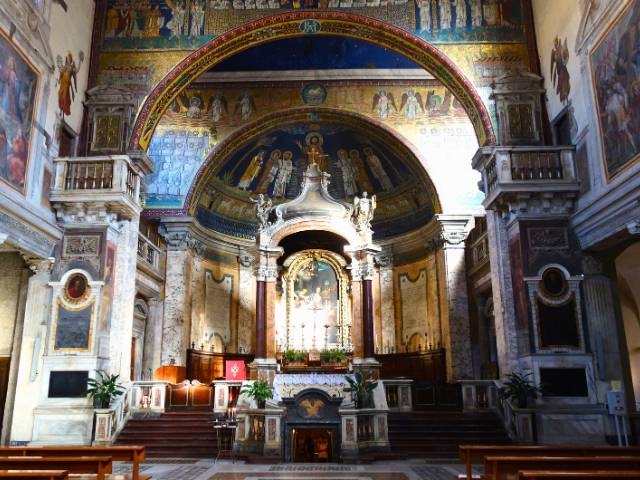 The mosaics are breathtaking, but are only lit up when visitors put a euro into the small machine so don't forget to bring some coins with you!
The mosaics are breathtaking, but are only lit up when visitors put a euro into the small machine so don't forget to bring some coins with you!These mosaics date back to the 9th century and are unusual in that they weren't replaced or covered up as in many other churches around Rome.
There's always something different to see in Rome, and these mosaics are something I return to over and over again.
San Francesco a Ripa
San Francesco a Ripa, dedicated to Saint Francis, was built on the site of a Franciscan monastic complex in the Trastevere neighborhood.
In the last chapel on the left, you'll find one of Bernini's masterpieces, his statue of the Blessed Ludovica.
 Bernini's work appears in many churches across Rome but this might be my favorite example of his artistry!
Bernini's work appears in many churches across Rome but this might be my favorite example of his artistry!Saint Francis himself stayed in the monastery on multiple occasions in the early 1200's when he was visiting Rome.
The close Franciscan connection meant the church was not subject to substantial redesigns over the centuries.
Renaissance and Baroque churches in Rome
As the religious, political and social landscapes of Italy changed, so too did the architecture.
In the Renaissance and Baroque periods much grander churches began to appear all over Rome.
Some visitors find these a bit over the top, but I think that even if they appear garish at first glance, there is a lot to appreciate!
Il Gesù
One of the most beautiful churches in Rome and one of the first examples of Baroque architecture in the city, Il Gesù was built in the late 16th century.
Built by the Jesuit religious order, it is still their mother church today.
The founder of the Jesuit order, Saint Ignatius of Loyola, had prayed to an image of the Virgin Mary which was displayed in a church that had stood here, but this church was not particularly impressive.
The Jesuits decided to build a brand new church in the same location, filled with beautiful artwork.
The heavily decorated ceiling of Il Gesù is one of the most impressive in Rome.
Make sure to use the convenient mirror positioned to allow you to study this rather than strain your neck!
Sant'Andrea della Valle
Dedicated to Saint Andrew, Sant'Andrea della Valle is most famous for being the location of the first act in Puccini's opera Tosca.
Thanks to its central location and stunning decor, many of the chapels belonged to famous Roman families and there are also two popes buried here.
This is one of my favorite churches to show first-time visitors to Rome.
It does not look particularly different to other churches from the outside but when they walk inside, it always gets a wow!
Santa Maria degli Angeli e dei Martiri
When Pope Pius IV decided to build a church on the site of the ancient Roman Baths of Diocletian, he enlisted the 86-year-old Michelangelo to design the church.
Michelangelo integrated the new church into the ruins of the Roman baths, creating a fascinating mix of old and new.
Don't miss the sundial inlaid in the floor which was added for the Jubilee celebrations in 1700, complete with depictions of star constellations and the zodiac.
Sant'Ignazio
Inspired by the church of the Gesu, Orazio Grassi, a Jesuit mathematician, designed this church at Piazza Sant’Ignazio in a similar style.
Like Il Gesù, Sant'Ignazio has an astonishing ceiling, but can you see what is odd about the dome?
While it appears to be a regular dome, it is in fact a flat ceiling that has been cleverly painted to make it look like there is a dome!
Sant'Andrea al Quirinale
The grand semicircle staircase that leads up to the entrance of this church, designed by the great Bernini, is topped by two columns and the coat of arms of Cardinal Pamphiji who commissioned the building of the church.
Inside there are many works of art, including paintings, sculptures and bronze work.
Close to the Quirinal Palace, the church is elliptical in shape which gives it a very distinctive feel when you're inside.
As there are more than 900 churches in Rome, this is just a small sample of what you can see when visiting the Eternal City.
Our advice?
If you see a church when walking around the city, be sure to go inside as you'll never know what you may find!
Romewise's Top Travel Resources
Ready to book your trip to Rome? Take a look at these helpful links to companies we use and trust:
- Keep your travel spending simple with the Wise card, which removes all the worry about exchange rates and high transaction fees all over the world
- Search for and book your perfect accommodation
- Our complete guide to what to pack for Rome
- The number one travel accessory, a multi-point travel adapter and voltage converter
- Browse a huge range of tours in Rome and beyond
- Experience unique tours and special access to Rome's most popular sights
- Protect yourself with comprehensive travel insurance
Within this post there are some affiliate links for products and services. For more details about our affiliate policy click here.
Get your 100% free Rome trip planner now!
Simply sign-up today for our free newsletter and get the Romewise Quick Start guide to Rome:
We are committed to respecting your data. Click for our Privacy Policy.
Comments? Questions? Suggestions?
Please come over to the private Romewise Facebook group and join in the conversation.
You will often find me there, happy to answer your questions / comments!
You will also meet other Rome lovers and experts, too.
What are you waiting for?
- Romewise Home Page
- churches in rome

